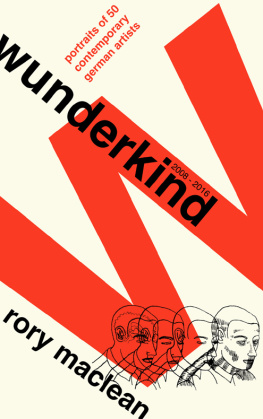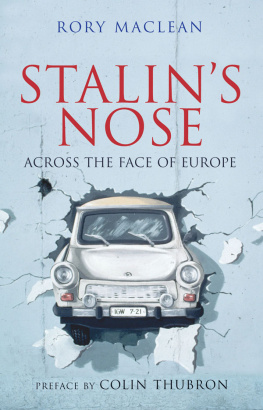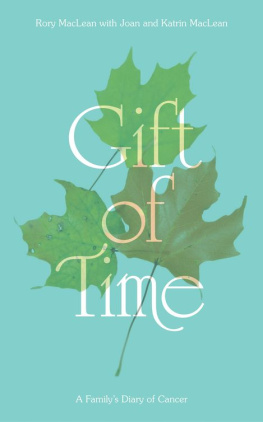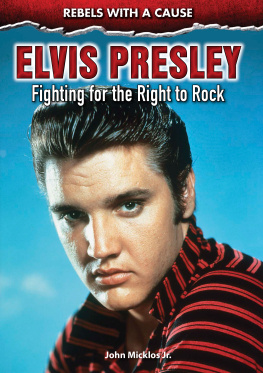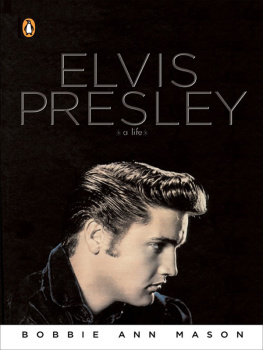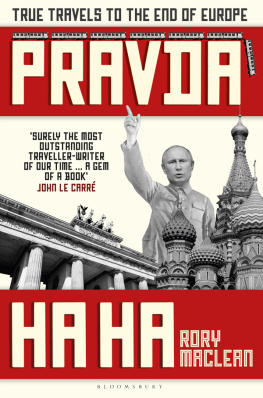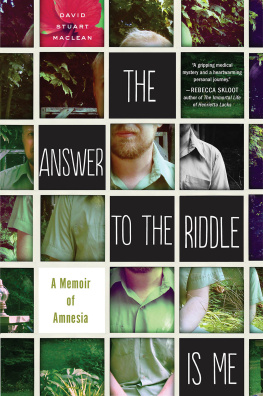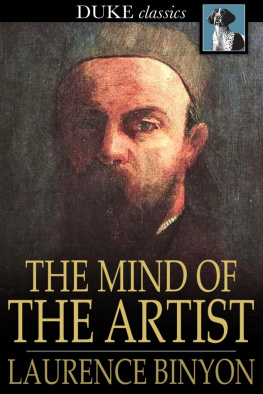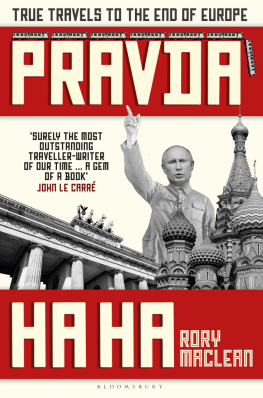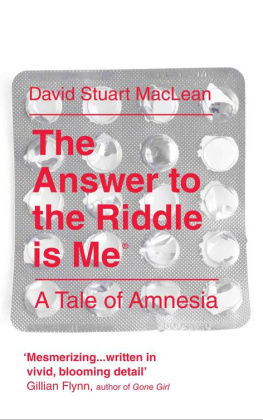Wunderkind: Portraits of 50 Contemporary German Artists
2008 2016
Rory MacLean
Contents
Introduction
What makes an artist? What forces and inklings drive a young man or woman to make their own journey, to travel outside the flow yet to be a part of it? And where does their voyage begin? In imaginary childhood games? In a chance encounter? With inherited enthusiasms? At the sensitive core of the human heart?
Over the last eight years, I have tried to answer these and other questions in almost one hundred interviews with working German artists. I have looked at how a childhood obsession or spark of inspiration develops in the creative imagination. I have followed the journeys of a platinum rock star and a struggling caricaturist, walked beside best-selling novelists, and traced the story of the godfather of techno. Ive tried to understand how these individuals have succeeded, where they have stumbled and fallen, and how theyve survived.
Most of the interviews took place in Berlin, Europes capital of reinvention. That citys identity has always been based not on stability but on change. Over the centuries Berlin recreated itself from a mean and artless outpost to Hohenzollern garrison town, the Babylon of the world during the Weimar years, Hitlers capital of war and then the flash point of the nuclear age. The divided city then emerged from the Cold War as a virtual blank canvas. After 1989 thousands of German and foreign artists aspired to create a new artistic life there, a kind of artsy communism: a creative utopia of collaboration and acceptance infused with a pioneering spirit, according to the writer, critic and cultural journalist Kimberly Bradley. In its crumbling tenements and vast, peanut-priced studios, they jumpstarted a greater community of musicians, club kids, and visual producers colonising the abandoned inner city, working together mixing genres and scenes.
In those early days Tacheles was central to Berlins new understanding of itself. Only three months after the fall of the Wall, a group of artists had occupied a war-damaged building on Oranienburger Strasse in the old East. The five-storey ruin, which had served in its time as a department store, an SS headquarters and a propaganda cinema, was within weeks of demolition. But the artists calling themselves Knstlerinitiative Tacheles fought for its preservation, and found themselves at the heart of an experiment in the power of the imagination. Huge murals were emblazoned on its blitzed exterior walls. Steel sculptures advanced from its doorways onto the street. Layer upon layer of graffiti covered its stairwells, and rubbish collected in its alcoves like organic works-in-progress. Over the next 25 years hundreds of artists from around the world worked in its 30 studios: painting canvas, moulding clay, developing images, composing music, interpreting and distilling life.
Tacheles is a guerrilla movement. Its a bastion, one resident artist-cum-squatter told me in 2010. But today were under siege.
By that year too much money had started to flow through swiftly gentrified Berlin for its artists to remain a guerrilla movement, let alone be communal and bohemian. Tacheles may have wanted to endure as an independent, public art house but Berliners or at least their leaders and institutions preferred sure profit over a utopian ideal. Within 24 months apartment prices in Mitte quadrupled. Aspiring painters and dancers took to worrying more about rent increases than their inner muse. Overnight the rent on the Tacheles building was raised from 50 cents to 17,000 per month. When the co-operative did not pay, the property was seized and slated to become a 400 million signature development of inner-city squares, apartments, restaurants and exclusive shops.
This speed of change in reunited Germany as a whole but especially in Berlin made it an ideal place in which to observe the forces and sensibilities that make and sustain (or undermine) an artist. On the following pages are interviews with 50 men and women who during those years chose to follow their passion, to break rules and make new ones, to reinvent themselves like the city itself. It is in no way a definitive list. My choices were guided by instinct, by serendipity and by the desire to produce a rounded, inclusive and informative portrait of individuals for whom creative work is the very point of being alive.
I believe that the creative spirit transforms the world. A gift of talent is bestowed on an artist and he or she labours in its service. The fruit of their toil is then offered to us all, where it in turn can awaken our individual gift or dream. Some of the artists interviewed believe that art is a weapon, others that art can heal, many found their voice in defiance of communist repression or capitalist materialism, others cite Russian literature, Christian iconography, Joseph Beuys, even Elvis Presley as their inspiration. In these pages all have aspired to articulate their creative process from a sensual, sensory or intellectual starting-point to the full expression in aesthetic beauty and purity of idea, and so remind us that there are as many ways of living and thinking as there are individuals.
This book would not have been possible without the support of the Goethe Institut, especially Jens Boyer, Sabine Hentzsch and Elisabeth Pyroth. All interviews are dated and appear in their original form, so as to be true to their time, and all have been updated with new information. Titles of books, songs and artworks have been translated or not at the request of the artists. As much of their work slips between disciplines, from poetry to photography and performance for example, chapter groupings should not be considered fixed or definitive. I am grateful to Katrin MacLean for translations and so much else, to Finn MacLean for the cover design, to Kerstin Hille for her wonderful illustrations (or better, illuminations) and above all to the artists themselves free thinkers who turn the ordinary into the extraordinary and trusted me to share their ideas, stories and journeys with you.
Berlin 2016
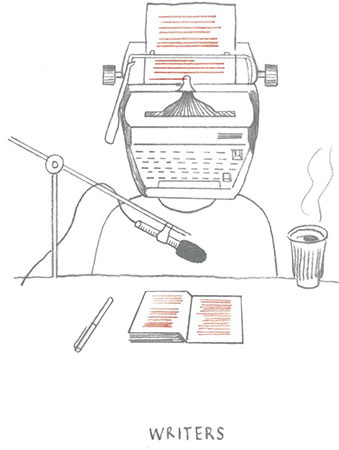
Thomas Brussig

Early autumn leaves crunched and crackled under my wheels as I cycled along Pallas Strasse to lunch. Thomas Brussig, the cheeky, thoughtful, 43 year old Wunderkind of the new (East) German literature, had offered me a choice of Berlin restaurants. Viennese schnitzel or Korean Catholicism? he had said. Its your call. Id chosen Korean Catholicism of course; how could I do otherwise in reborn, open-minded Germany?
We perched on stools by the window, eating a spicy hot pot from heavy stone bowls, surrounded by Biblical quotes. The Korean waitress wore the Icthys Christian fish symbol on her apron. I wondered aloud about the importance of that other doctrine in Brussigs work.
I grew up under communism, he told me. Of course I was luckier than others. It was not so cruel for me because the times were changing. But there was a lot of anger in those days. I have paid in my life for writing my books.
Brussigs most successful book is Heroes Like Us, a bold and hilarious comedy of terrors set around the fall of the Berlin Wall. Its now been adapted for screen and stage, as well as translated into almost a dozen languages, but before all that it was a runaway best seller in Germany.
When the book was first published, there was a kind of relief in the east that you could make jokes about totalitarianism. People were happy that such a funny and crazy story could be brewed from those days. And in the west, reading about East Germany had always felt like a duty.
Next page
